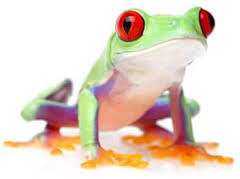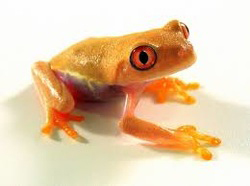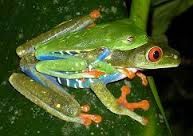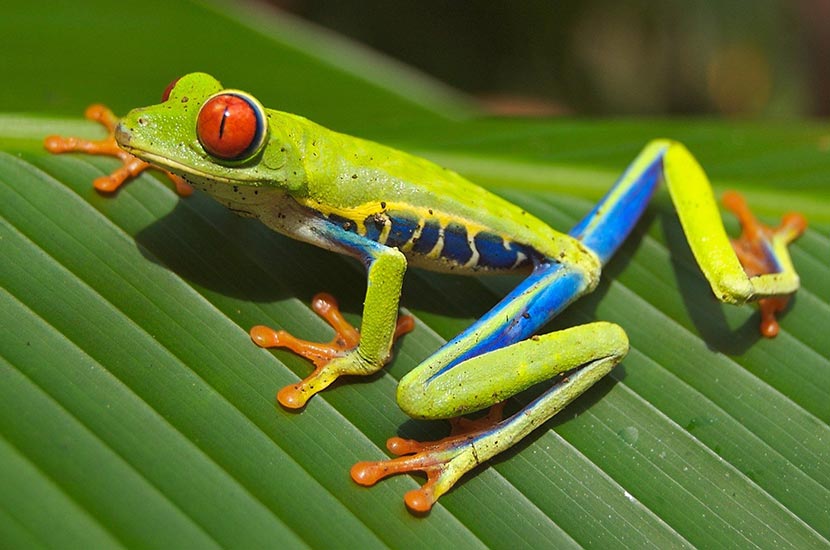by Erica Mede, CVT
Natural History
 These arboreal frogs with bright red eyes, green bodies, blue limbs, and orange toes are one of the most popular frogs in the pet trade for obvious reasons but colors do vary based on origins. These stunning nocturnal frogs are native to the rainforests of the Pacific and Atlantic lowlands and foothills of Central America and have become the poster child for the rainforest! Most of the animals in the pet trade are exported through Nicaragua. The calls from the males are heard echoing through the rainforest and homes of keepers through May and December. These 2-3 inch long frogs (females are generally the larger of the species) live 4-10 years.
These arboreal frogs with bright red eyes, green bodies, blue limbs, and orange toes are one of the most popular frogs in the pet trade for obvious reasons but colors do vary based on origins. These stunning nocturnal frogs are native to the rainforests of the Pacific and Atlantic lowlands and foothills of Central America and have become the poster child for the rainforest! Most of the animals in the pet trade are exported through Nicaragua. The calls from the males are heard echoing through the rainforest and homes of keepers through May and December. These 2-3 inch long frogs (females are generally the larger of the species) live 4-10 years.
Feeding
Red eyed tree frogs are insectivores and tend to become obese with over feeding like most frogs. Adults are frequently fed earth worms, crickets, roaches, horn worms, and silk worms. Tree frogs under 3 inches should be fed every day to every other day. Frogs over 3 inches in length should be fed every 2-3 days.
Placing the food in a dish or on a flat rock is an appropriate option. Feeding with forceps is a very popular method as well. Calcium supplementation should be added to the food weekly and a multivitamin supplement every 2 weeks.
Enclosures
 These frogs can be housed in pairs or small groups of females with one males. A 10 gallon aquarium or equivalent sized container such as a Sterilite or Rubbermaid bin is generally acceptable for two adults. These are arboreal frogs and vertical space is important to consider. Many keepers find that using non-conventional enclosure such as plastic storage boxes is not only easier to maneuver in their homes but also less stressful for the animal due to the opaque nature of the sides. Juveniles can easily be maintained in a Critter Keeper style enclosure, a 2.5 gallon aquarium, or similar sized plastic container.
These frogs can be housed in pairs or small groups of females with one males. A 10 gallon aquarium or equivalent sized container such as a Sterilite or Rubbermaid bin is generally acceptable for two adults. These are arboreal frogs and vertical space is important to consider. Many keepers find that using non-conventional enclosure such as plastic storage boxes is not only easier to maneuver in their homes but also less stressful for the animal due to the opaque nature of the sides. Juveniles can easily be maintained in a Critter Keeper style enclosure, a 2.5 gallon aquarium, or similar sized plastic container.
Substrate
Paper towel is by far the easiest to clean and cheapest substrate to use. However, it must be changed daily and doesn’t offer any aesthetics. Top soil it a common substrate providing a naturalistic look to the enclosure. Soil must be spot cleaned daily and completely changed out every 2 weeks to prevent bacteria and fungus build-up. Moistened terry cloth towels are also utilized for substrate since they can be easily changed out. However, a few backups will be needed and the towels must be washed and dried WITHOUT fabric softener preferably. The substrate needs to be moistened at all times with dechlorinated water. Tap water that has been dechlorinated chemically or “aged” is perfectly fine. Avoid distilled water due to the lack of minerals in the water.
Temperature
 Red eyed tree frogs can be easily maintained in 76-82°F ambient temperatures. At night, the temperature can drop as low as 72°F. Heating the enclosure is easily achieved using under tank heaters mounted on the side of the tank. Heat cable, heat tape, and other methods of heating can be utilized as well. Basking lights are contraindicated. The temperature should be maintained with the use of a thermostat and monitored with a thermometer at the level of the substrate. Sphagnum moss is an excellent way to keep frogs moist but care must be taken that it is changed frequently and is in a place where the frog will not accidentally ingest it attempting to eat.
Red eyed tree frogs can be easily maintained in 76-82°F ambient temperatures. At night, the temperature can drop as low as 72°F. Heating the enclosure is easily achieved using under tank heaters mounted on the side of the tank. Heat cable, heat tape, and other methods of heating can be utilized as well. Basking lights are contraindicated. The temperature should be maintained with the use of a thermostat and monitored with a thermometer at the level of the substrate. Sphagnum moss is an excellent way to keep frogs moist but care must be taken that it is changed frequently and is in a place where the frog will not accidentally ingest it attempting to eat.
Humidity
Humidity is extremely important to the health of tree frogs. The humidity in the enclosure should be maintained around 60-80%. This is easily checked with a hygrometer and maintained with a hydrostat. Frequent misting, moistening of the substrate, large water bowls, and foggers can all be used to maintain higher levels of humidity.
Lighting
 Tree frogs do not have many lighting requirements. They require a light cycle of 10 hours of light and 14 of darkness. An ultraviolet (UVB) light such as a ReptiGlo or a ReptiSun 5.0 can be utilized and is recommended.
Tree frogs do not have many lighting requirements. They require a light cycle of 10 hours of light and 14 of darkness. An ultraviolet (UVB) light such as a ReptiGlo or a ReptiSun 5.0 can be utilized and is recommended.
Enrichment
Water bowls should be kept shallow to prevent accidental drowning as these frogs are extremely poor swimmers. The water ideally should only be high enough for the frog to submerge itself if desired. Water should be changed at least daily and only clean, dechlorinated water should be used. Never use distilled water as this will cause health problems in frogs! Fake foliage such as silk leaves can be used without problems and pose the benefit of being easily cleaned. Branches should be set in a way that allows climbing for these arboreal frogs. Large pieces of cork bark provide excellent hiding places that help Red Eyed tree frogs feel more secure.
Sources and Suggested Reading
- Frogs and Toads, Devin Edmonds
- Frogs, Toads, and Treefrogs, Philip Purser
If you have any questions, please feel free to call us at (502) 241-4117.

